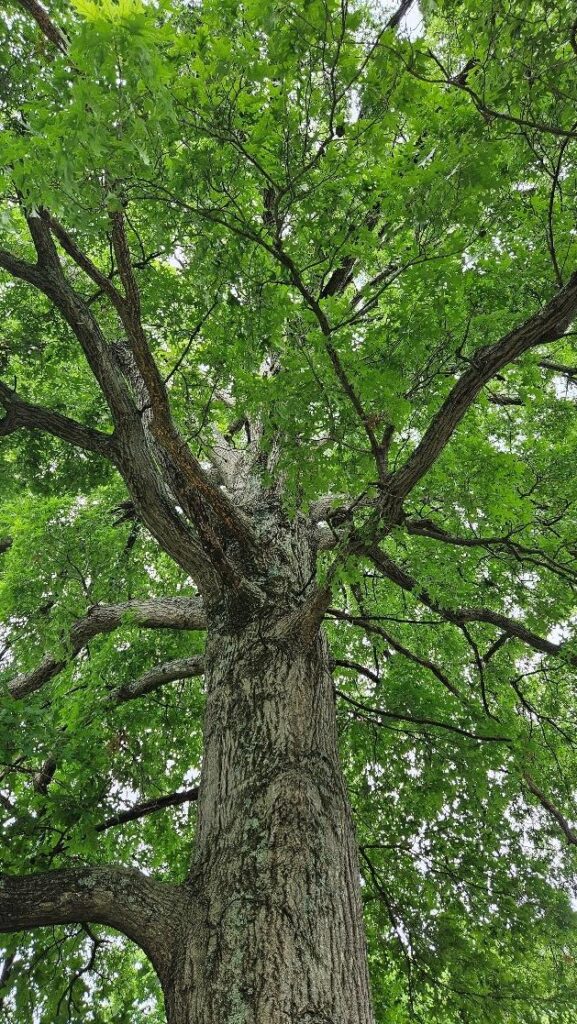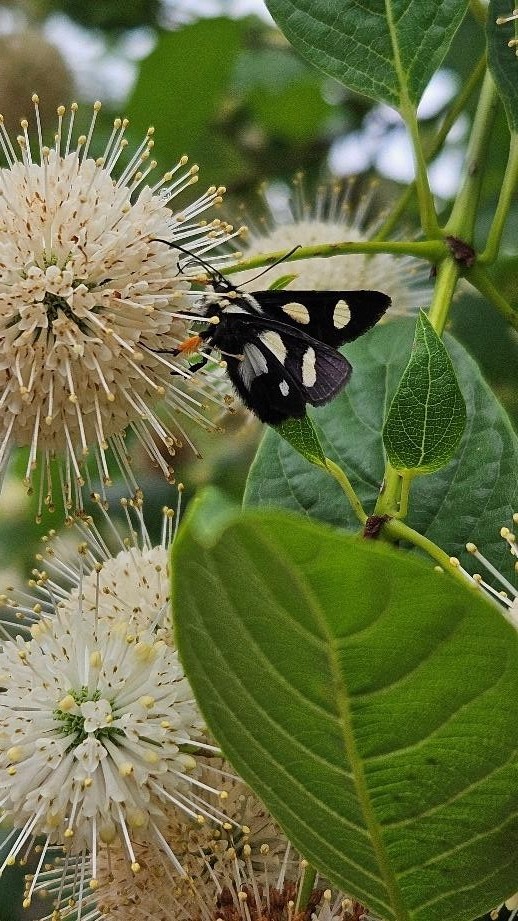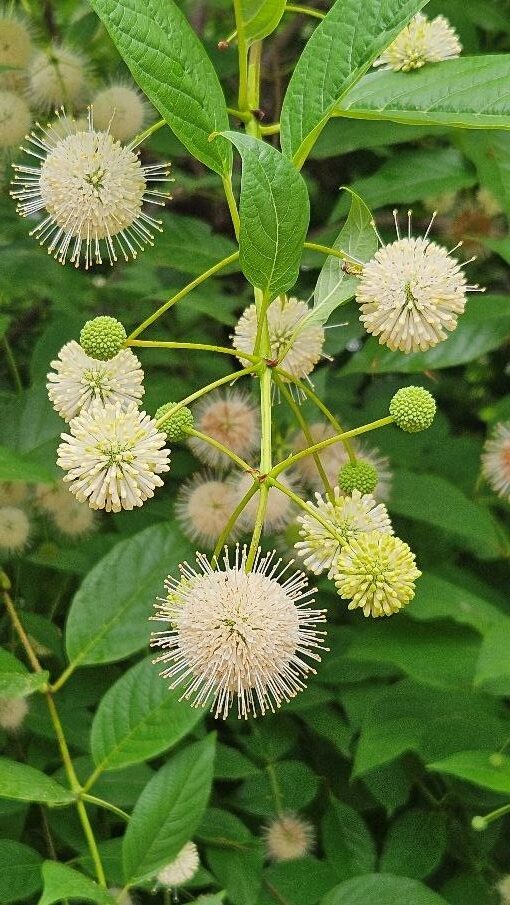Written by Margaret Carreiro, President of Wild Ones Louisville
Yes, it was SUPER HOT the afternoon for this tour and I really wondered if WOL should cancel it. But I was reassured that the trees on Julie’s property offered a lot of cooling shade. And besides, we could all go inside to cool off in the AC. When I pulled up to their home, I saw cars but no one loitering outside, as is usually the case because we all walked in a bee line to enjoy the cantaloupe and other refreshments in the kitchen in air conditioned splendor. But once we had gathered inside and chatted a bit, we bravely went outside and, you know?- it actually was at least 10 degrees cooler out front than in the sunny patches because of Julie’s trees, particularly this one MAGNIFICENT TALL OAK out front that truly did an awesome job of making us all feel comfortable. Really!
While Julie started to show us around her property planted all around in different native flower beds, I couldn’t help but notice that her trees were surrounded, not by grass, but by plants that provide “soft landings” for the caterpillars and pupae of butterflies and moths (and other insects). Julie has been and is an avid proponent of educating folks here about the need to incorporate soft landings below the canopy dripline of trees, so I should not have been surprised.
What is “soft landings” about? Well, we all know that many native trees, especially oaks, cherries, willows and pines, are host plants for hundreds of Lepidopteran species, especially moths. Females of some moth and butterfly species will seek out host trees to lay their eggs. The caterpillars that emerge eat the leaves, and birds take the caterpillars to feed not just themselves but mostly their nestlings. But once they have eaten their fill, these caterpillars will either crawl down the tree trunk to the soil below and start to dig down into the soil to form their pupae, or they attach to the leaves and pupate there. And when the leaves fall in autumn, the pupae overwinter in the soil amid the plants below the tree. But what happens if instead we maintain grass under those trees? You guessed it- we mow the grass and those unlucky pupae that have trouble digging down into the compacted grassy soil. Then instead of being helpful to moths, that oak or pine or cherry will have become, what we call, and ECOLOGICAL TRAP. Why a trap? Because the tree entices the adult female moth or butterfly to lay her eggs on their leaves, but, because of how we manage plantings growing below that tree unwittingly winds up killing the female’s children. Not what we want, I would think. So, I was impressed with the plants that Julie has planted or allowed to grow as soft landings under her trees. Thank you, Julie, for reminding us about the critical importance of soft landings!
If you want to know more about soft landings, I encourage you to visit: https://www.pollinatorsnativeplants.com/softlandings.html
It is a terrific website with cartoon explanations and many photos of examples of different kinds of soft landings. The website includes more examples of the types of plants you can grow under trees.
Julie has also planted many shrubs along with perennial non-woody perennials providing habitat niches for various critters in three-dimensional space. The shrub that was showing off at the time was her Buttonbush and it sure is a pollinator magnet! The non-woody perennial flowers in bloom that day were also bringing in a fair amount of pollinators despite the heat! One native flower bed was spectacularly colorful and I could have spent a long while there watching pollinators and just enjoying the colors. Blue and violet from the Downy Skullcap and Blazing Stars complemented the yellows and oranges of sunflowers and butterfly milkweed- against a background of pink wild bergamot! Oh, my! A painters delight! Sometimes I wish they could bloom that way for months of the year, don’t you? And I can tell you, I have NEVER seen a Butterfly Milkweed that has ever gotten as tall! Mine barely survive (and often do not) in my limestone quarry “soil”, so I have to admit I was a bit envious. I often tell my friends that I might as well have just put $10 bills into the ground instead! LOL! So it is nice to see someone growing butterfly milkweed successfully.
Meanwhile, Julie’s husband Glen was showing us the long stretch of blackberry shrubs he was growing and a week later I came to buy a couple of tasty quarts! They also grow vegetables in their rich loamy soil!
And thanks to Julie, Alicia Bosela of Ironweed Nursery also came to set up a table to sell her native plants. We thank her for driving such a long way from Waddy to do so. She brought a broad array of natives with her and those who came bought quite a few. We thank Alicia for coming and hope she found it worthwhile. It is always fun to talk with her. If you want to check out her nursery, Ironweed Nursery is at 400 Waddy Roady in Waddy, KY. You can set up an appointment by calling 270-250-3587. And you can email her at [email protected]
So, to summarize tall shade trees really do help you beat the heat and soft landings are important to establish beneath trees. And, if you have both sunny and shady spots in your property, a diversity of native flowers that bloom across the seasons helps pollinators, like native bees, complete their life cycles. Thanks, Julie, for the tour and for using your land, knowledge and skills so your property not only looks beautiful but sustains nature around you!
Not only did Julie welcome us to her home, but her magnificent stately oak did as well. That oak really cooled off her property on an extra HOT day!

One soft landing may be as simple as allowing our wild blue violets to grow around a tree.
While others may consist of ferns and some of our native spring ephemerals like this Meadow Anemone underneath a different tree.
Julie and Glenn’s landscaping consists of not only tall and short trees and flower beds, but many shrubs which help form an understory. This provides a three-dimensional landscape that increases the volume of niche space available for different species of invertebrate and vertebrate animals.
And this bed of summer-blooming flowers was splendid. So many pollinators gathering around flowers of different shapes and color.
The Buttonbush was showing off and the Eight-spotted Forester Moth was happy about that!


Glen decided that the blackberries needed another week to ripen.
Alicia Bosela, owner of Ironweed Nursery, drove up all the way from Waddy to sell her native plants to us.
THANK YOU, JULIE, FOR A SPLENDID NATIVE GARDEN TOUR FOR OUR WILD ONES LOUISVILLE MEMBERS!
